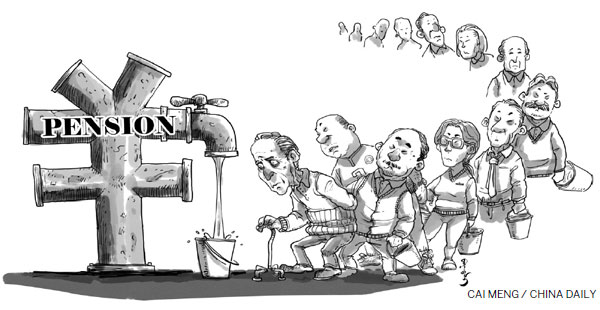Rising pension burden poses a problem
Updated: 2015-03-12 07:30
By Zheng Bingwen(China Daily USA)
|
|||||||||
Premier Li Keqiang has said in the Government Work Report that basic pension standards will be raised by 10 percent this year. Although this reflects the government's concern about retirees, it has sparked a debate on the sustainability of the pension scheme because the authorities have also decided to extend the retirement age.
According to the latest official data, in 2013 the national average pension was 1,914 yuan ($305), or about 43 percent of the average monthly wages before retirement, and the accumulative balance of the national pension fund was 2.83 trillion yuan, or 5 percent of GDP. The overall pension income and expenditure in 2013 was 2.17 trillion yuan and 1.85 trillion yuan, accounting for 3.8 percent and 3.2 percent of GDP.
Urban pension funds are managed by local governments, not the central government, and there are 2,000-odd fund pools nationwide. Compared with some other countries, this is a low social pooling level and can seriously harm the financial sustainability of the pension insurance system. Specifically speaking, under the current system, two explicit pension debts have become a cause of concern.
First is the empty personal accounts. The personal accounts have always been empty since they were established two decades ago, with the premiums paid by employees and employers having been used to pay retired people's pension.
The central government started expanding pilot projects in 2001 to solve the "empty personal accounts" problem. The real contributions to personal accounts across the country add up to 415.4 billion yuan, with the credit on account reaching 3.51 trillion. The balance of China's pension insurance fund is 2.83 trillion yuan, so theoretically the gap in pension fund is not serious. But since the balance is concentrated in the eastern region, it is difficult to achieve financial defined contribution to personal accounts because of the low social pooling level. A defined contribution plan is a type of retirement scheme in which the employer or employee, or both contribute to a pension fund on a regular basis.
Second, almost half of China's provinces, especially the central and western provinces, cannot make ends meet when it comes to pension payment; they rely on financial subsidy to meet their pension expenditure. In 1998, pension transfer payment amounted to only 2.4 billion yuan, which sharply increased to 65.1 billion yuan in 2005 and 301.9 billion yuan in 2013. From 1998 to 2013, the overall financial transfer payment added up to 1.82 trillion yuan, which is equal to about two-thirds of the entire pension fund balance.
Without systematic reform these two explicit pension debts will increase with each passing year. In fact, the system design is unreasonable, because all pension funds are deposited in banks, making them cheap deposits for the banks.
The existing system has two recessive pension debts too. First is the personal accounts' reliance on financial subsidy. Personal accounts have inherent design defects despite being part of defined contribution plans on paper. If an account holder dies before retirement, the entire credit balance has to be inherited by his/her family. And if the account holder lives a long life, he/she will receive pension till his/her death. This shows the pension fund has financing gaps which can be filled only by a social pooling fund, that is, public finance.
Second, the rapidly increasing aging population will exert more pressure on social pooling funds. At 14.9 percent of the total population in 2015, the percentage of people aged 60 or above in China is lower than that in the G8 countries. But in 2049, the percentage of senior citizens in China's population is estimated to increase to 33.9 percent, which will be higher than that in major developed countries such as the United States, the United Kingdom, France and Canada.
Moreover, the pension insurance scheme of not only urban residents but also rural people depends on financial subsidy. In 2013, the overall financial subsidy for the pension system was about 500 billion yuan, or 0.88 percent of GDP and 3.9 percent of the fiscal revenue. This is expected to increase in the coming years.
These developments and the fact that the Third Plenum of the 18th Central Committee of the Communist Party of China in 2013 announced that actuarial balance would be maintained in the basic pension system and the personal account system would be improved indicate a transformation from a financial defined contribution to a notional defined contribution plan.
The author is director of the Center for International Social Security Studies, affiliated to the Chinese Academy of Social Sciences.

(China Daily USA 03/12/2015 page12)

 Christie's to auction landmark Chinese collection
Christie's to auction landmark Chinese collection
 Chinese manufacturers keeping Apple Watch ticking
Chinese manufacturers keeping Apple Watch ticking
 Hutong culture captured on porcelain plates
Hutong culture captured on porcelain plates
 Foreigners at the 'two sessions' over the years
Foreigners at the 'two sessions' over the years
 Top 10 most valuable airlines brands in the world
Top 10 most valuable airlines brands in the world
 Qipao beauty in Chinese oil paintings
Qipao beauty in Chinese oil paintings
 Daily snapshots of 'two sessions' - March 10
Daily snapshots of 'two sessions' - March 10
 Scroll revives cheongsam beauty in New York
Scroll revives cheongsam beauty in New York
Most Viewed
Editor's Picks

|

|

|

|

|

|
Today's Top News
De Blasio pressed on Lunar New Year
Domestic jet 'to make maiden flight later this year': official
Shambaugh China essay rebuffed
Arkansas U. to expand China ties
CNR, CSR merger passes overseas antitrust scrutiny
Official urges Dalai Lama to forsake evil ways
Taiwan welcome to join WWII commemorations: Spokesperson
Two University of Oklahoma students expelled over racist video
US Weekly

|

|








